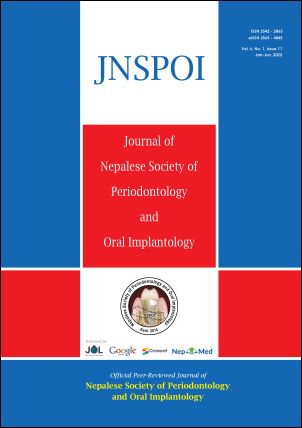Self-reported Gingival Bleeding among Undergraduate Students and Interns of a Medical College
DOI:
https://doi.org/10.3126/jnspoi.v6i1.52999Keywords:
Gingival bleeding, medical college, Nepal, self-report, undergraduate studentsAbstract
Introduction: Gingival bleeding (GB) is a common clinical finding in periodontal diseases. It is one of the most easy and reliable parameters for evaluating periodontal status. Self-reported GB provides vital information about periodontal diseases of a population and their periodontal treatment needs.
Objective: To assess the self-experience and awareness of GB among undergraduate students and interns of a medical college.
Methods: This descriptive cross-sectional study was conducted among 382 undergraduate students of MBBS, BDS, and Nursing at
Kathmandu Medical College using online questionnaire. Participants were selected by convenience sampling from December 2021 to March 2022 after ethical clearance. Responses entered into Google Forms were exported to Microsoft Excel Sheet 2019 and descriptive analysis for calculation of frequency, percent, mean, and standard deviation was done.
Results: A total of 382 undergraduate students (female: 244, 63.9%) participated with ages ranging from 17-31 years. Most respondents (204, 53.4%) were from BDS. About two-third participants (241, 63.1%) experienced gingival bleeding. Most participants (260, 68.1%) believed there was a relation between the gingival disease and systemic disease. However, very few of the participants believed that antihypertensive (146, 38.2%), anticonvulsant (138, 36.1%), and immunosuppressive (166, 43.5%) drugs could increase gingival bleeding. Not even half (179, 46.9%) believed they knew about gingivitis.
Conclusions: Self-reported GB was seen in majority. Though many were aware about the association between gingival and systemic diseases, only few knew about the adverse effects of antihypertensive, anticonvulsant, and immunosuppressive drugs in gingiva. The gingival health awareness of undergraduate students, needs to be reinforced.
Downloads
Downloads
Published
How to Cite
Issue
Section
License
Copyright (c) 2022 Nepalese Society of Periodontology and Oral implantology (NSPOI)

This work is licensed under a Creative Commons Attribution 4.0 International License.
© Nepalese Society of Periodontology and Oral implantology (NSPOI)
Licenced by Creative Commons Attribution 4.0 International License.




